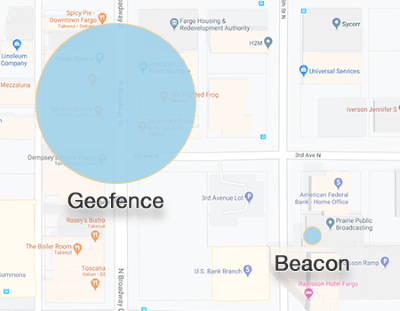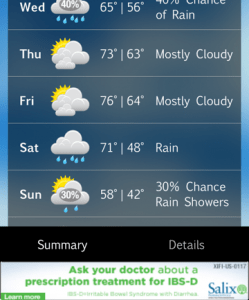Last Updated on August 18, 2025
Location-based marketing has been around for a while. Marketers have used ZIP codes to send personalized marketing messages to target audiences. However, these tactics are limited. For example, you can’t trigger ads in real-time or at the moment of highest intent. But what if you could target the right customers at the right place and time?
Enter geofencing. It’s a location-based technology that allows marketers to hyper-target prospects in or near a specific building, like a hotel hosting a weight loss conference, a competitor’s waiting room, or gyms near your chiropractic clinic.
(Source: The above image illustrates a geofence. The highlighted circle marks the virtual or electronic boundary around a physical location.)
Geofencing marketing uses GPS, Wi-Fi, or cellular data to activate messages when a mobile device enters or leaves a geofence. These could be push notifications, in-app, or social media ads.
The logistics, automotive, and retail industries use geofencing with success. In this guide, you’ll learn the benefits of geofencing in healthcare. We’ll share use cases and address concerns around data privacy.
Benefits of Geofencing in Healthcare
When it comes to healthcare marketing, location is everything. Local SEO statistics show the growth of ‘near me’ search queries at over 500%. This means customers aren’t traveling long distances for healthcare solutions.
Healthcare geofencing helps medical professionals capitalize on these local markets.
That’s not all. Besides marketing to hyper-targeted, high-value prospects, healthcare geofencing improves patient engagement and privacy. It streamlines workflows and enables better data collection. Here are the specific benefits of geofencing in healthcare.
1. Improved patient engagement and satisfaction
When incorporated with a patient scheduling system, geofencing sends appointment reminders, improving communication between patients and healthcare providers. It can send health tips in an engagement app.
Geofencing in healthcare also makes the patient experience convenient. Imagine arriving at a large hospital. You don’t know where parking or the urologist department is. Geofencing can help you find your way around the hospital.
Geofencing can also automate patient check-in, reducing administrative workload and wait times. When a person enters the virtual perimeter, they receive a push notification asking a series of questions. For example, is this an emergency? What is the condition you’re seeking treatment for? Have you been treated for this condition before? What is your pain level?
When the patient leaves the geofenced area, the facility can send reminders to schedule follow-up visits or collect feedback about the customer’s experience.
2. Enhanced patient safety and security
The healthcare industry handles highly-sensitive information. Breaches in client data damage consumer trust and cost millions of dollars in liability claims. Geofencing technology prevents unauthorized access to confidential records on protected devices.
It does this by locking patient records, test results, or prescriptions when the mobile device exits the virtual fence. Advanced measures restrict or disable cameras, USB ports, Bluetooth, or other features that may compromise data security.
Healthcare geofencing comes with some data privacy and security risks. Location data is considered personal information under laws that protect consumer data, such as the California Consumer Privacy Act (CCPA) and the EU’s General Data Protection Regulation (GDPR). Consequently, you must obtain consent from patients to collect and use their geographic location and inform them about how your use and store this data.

3. Streamlined clinical workflows and improved efficiency
When healthcare facilities optimize resource utilization, they reduce costs and increase efficiency. The goal of clinical workflows is to maximize healthcare delivery processes. This enables the best patient care possible.
Geofencing streamlines this process by tracking medical staff, patients, and equipment. For example, you can monitor the status of beds and track patient location and movement from triage to admission. With Linear integration, you can keep track of the process from a real-time dashboard. You can notify the respective wards accordingly.
You can also allocate staff based on demand. If your automated dispensing cabinet is temperature-controlled, geofencing will alert you if it has been compromised, preventing spoilage and waste.
Location-based software reduces instances of wage theft. You don’t have to worry about fraudulent clock-ins and clock-outs when employees are tied to geofenced-enabled devices. The software enables you to track attendance and time spent in the perimeter. You don’t just reduce remuneration for non-work-related activities. You also have an accurate account of staff members present at work.
4. Better data collection and analysis
Geofencing collects insights from qualified and high-intent leads, enabling healthcare providers to produce highly-targeted and compelling ads.
One way you can collect data is with a well-timed survey. Send this, for instance, when a patient exits the geofence. The best time to collect feedback is immediately after their interaction with your business. It yields more accurate responses compared to surveys sent a week later.
Other examples of data collected from location-based software include:
Number of devices
Types of devices
Movement patterns
Device user’s location
Time spent in a specific location
Places the device has been
This data provides valuable insight into customer behavior and identifies opportunities for improvement. Let’s say you have a dental practice and set a geofence around nearby coffee shops. You can learn the peak days and times of foot traffic and send targeted ads for teeth whitening services.
Another insight location-based data gives is attribution rates. Attribution isn’t limited to measuring the success of a SaaS marketing strategy. You can also assess the performance of your marketing efforts by calculating how many devices exposed to a geofencing campaign ended in a conversion.
Geofencing Use Cases in Healthcare
Geofencing has various applications across different industries. We touched on some of these earlier – asset management, data security, and human resource.
Here are two typical use cases for geofencing in healthcare.
Marketing
The most common application of geofencing across all industries is marketing. Pharmaceutical companies use geofencing to target hospitals, clinics, and physician offices with direct-to-consumer (DTC) advertising.
Before the advent of smartphones, people would entertain themselves with magazines while they waited to see the doctor. It was common to see ads for medicines in many of these magazines. Now visitors use their mobile devices for entertainment, so pharmaceuticals buy ad space on thousands of mobile apps.
Below is an example of a DTC app ad.
(Source)
When someone opens the weather app (or any other app), they see an ad for an IBS medication. If the ad is relevant and the client sees it, they will likely ask their doctor about the medication.
Recruitment
Geofencing around a competitor’s location (AKA geo-conquesting) is an effective strategy for targeting high-intent customers. You already know they need your product or service.
You can use the same tactic to target qualified employees from various healthcare organizations. You can accelerate the recruitment process because you know they have the skills and experience you need.
NBC reported how John Hopkins All Children’s Hospital used geofencing to target potential candidates. The company created geofences around pediatric hospitals in several states. Whenever the candidate entered the geofenced zone, they’d see ‘help wanted’ social media ads for the hospital.
Implementing Geofencing in Healthcare
You will need geofencing software to implement a healthcare geofence. The best geofencing apps offer features like easy-to-use dashboards and analytics.
There are two steps to implementing healthcare geofencing: creating a fence and setting up a policy.
Creating a fence
You must have the following data when making a fence:
Longitude and latitude
Unique identifier
Radius
Number of fences
The longitude and latitude define the point of interest, i.e., the clinic, office, etc. The radius refers to the size and shape of the fence. The standard geofence is circular, but you can use polygonal geofences. Depending on your geofencing software, you may have a limited number of geofences.
Setting up a policy
After creating geofences, you must set up rules that define what actions should be performed for each geofence. For example, you don’t want to spam users with the same ads when they enter and leave a geofence. Your ads must be relevant and well-timed.
Ensuring Patient Privacy and Data Security in Geofencing
So, the big question is: is geofencing compliant with the Health Insurance Portability and Accountability Act (HIPAA)? Geofencing does comply with HIPAA regulations; it targets potential patients’ location data, not personal health information.
Location-based marketing may generate anonymous data. However, geographical location data is still classified as personal information in the CCPA and GDPR. Therefore, healthcare businesses must still be careful when handling that type of data.
So, ensure you’re not violating any of these laws. You must obtain customer consent to use and store location data. Users should also have the option to opt out. You also can’t send ads after users leave medical facilities, as this would be seen as targeting based on health information.
Conclusion
Patients are becoming more engaged in their healthcare. As a result, the healthcare industry is shifting to delivering personalized marketing to attract and retain high-quality prospects. One way healthcare marketers can do this is by geofencing.
By targeting customers in clinics and urgent care centers, you maximize marketing efforts by reaching out to people you know are interested in what you’re offering.
Healthcare geofencing can improve patient satisfaction, clinical workflow, and data analysis. The healthcare applications for the technology vary from marketing to recruitment. However, you must be careful as location data is protected under data privacy and security laws.
Ultimately, geofencing is a powerful tool for healthcare providers, but its full potential for security and efficiency is best realized when implemented as part of a comprehensive MDM for Healthcare platform. This integrated approach ensures that location-based rules, device security, and data protection work together seamlessly to safeguard patient information and streamline clinical operations.

Author Bio:
By Ashish Gupta, former Tech Lead for Machine Learning at Google AdWords (6 years) and a quant developer on Wall Street. Co-Founder & CEO of Polymer Search, the first no-code solution to make structured data more accessible. His goal is to help anyone extract exactly what is driving their performance metrics or ad spend, at any level of detail, and without special data science knowledge.
LinkedIn: https://www.linkedin.com/in/ashishgup


Thanks and regards..
pikashow
ppsspp emulator
After creating geofences, you must set up rules that define what actions should be performed for each geofence. For example, you don’t want to spam users with the same ads when they enter and leave a geofence. Your ads must be relevant and well-timed.
This is an excellent resource. I will definitely take all of your tips into careful consideration once I start to network my new blog.This will help me a lot with connecting to bloggers in my niche.
The content was really very interesting. I am really thankful to you for providing this unique information You have a good point here!
Your article is very helpful for me. I hope you will continue to write such good articles as well.